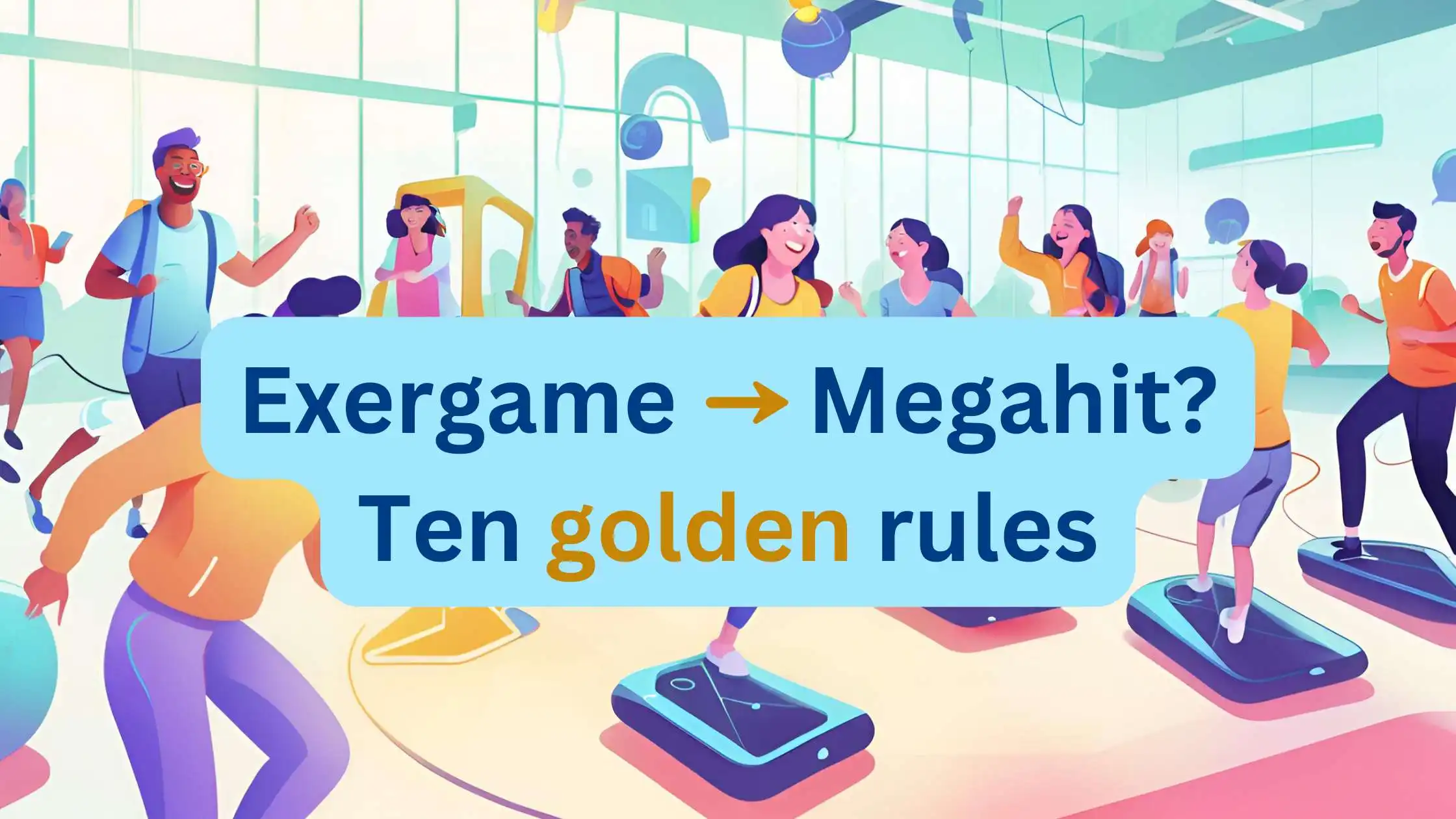Ten golden rules to turn your exergame into a megahit #
While exergames are not the same as virtual sports (see the about page for that 👀), it is nonetheless relevant to discuss and showcase the best practices around exergames. Hence, this blogpost!
Often, a virtual sport is rooted in what once started as an exergame. It makes sense that some exergames develop into virtual sports for two main reasons.
- Because the exergame becomes more closely linked to a traditional sport.
- Because the exergame’s underlying technology has developed and starts to meet new requirements in terms of accurate and valid measurements of physical output, which are needed for legitimate competitions to take place, for a seamless blend-in and use with sports training and practice, or for a seamless simulation of traditional sporting activities.
The reverse development is also possible, i.e., where a virtual sport (e.g. high-end simulator) trickles down to an exergame with fun game modes that focus more around physical activity rather then the traditional sport. While this showcases how these concepts are related and why it is important to discuss both virtual sports and exergames, it should also be noticed that not not all exergames will and should develop into virtual sports or vice versa.
Whitepaper based on experiences at the Sports Innovation Campus. #
Why this white paper? #
The sporty nerds at the Sports Innovation Campus have been working for years on developing and testing the most fantastic exercise games, or exergames. From our playground where innovation and sports meet, we’ve already set a lot of balls (literally and figuratively) rolling. From small-scale experimental student projects to the implementation of commercial exergames.
We’ve tried crazy things, laughed at failed experiments or applications, and above all learned a lot. And from all these experiences, we’ve distilled 10 golden rules to make (the implementation of) your exergame a mega hit.
Why should you read this? #
- Because you’re a game developer who wants to create a game that makes people sweat and smile at the same time.
- Because you’re a teacher who wants to get your students moving in a fun way.
- Because you’re a sports coach or -instructor looking for new ways to motivate people.
- Or because you’re just curious and want to know what’s important if you want to create or implement an exergame yourself.
In short, for anyone who wants to contribute to a world full of happy, playful, and active people, this white paper is a must-read.
What’s in this white paper? #
In this white paper, we share our best tips, learned from our successes and our blunders. We tell you everything you need to know to create or implement an exergame that not only gets people moving but also makes them laugh.
Don’t want to read the whole paper? No problem! We’ve also created a short summary for you so you can quickly get started or be inspired.
Summary #
Want to create or implement a successful exergame? Then follow these 10 golden rules:
- Define your goal: Do you want people to lose weight, build muscle, or just have a good time?
- Choose your target group: Children, adults, the elderly? Everyone has different needs.
- Make it fun: Add elements that challenge and reward people.
- Tell a story: A good story makes a game much more interesting.
- Make it customizable: Let players adjust the game to their own level.
- Give immediate feedback: So players know how they’re doing.
- Let them play together: Exercising together is so much more fun!
- Make it easy: Nobody wants to read a detailed manual to play a game.
- Collaborate: Involve experts from different fields.
- Motivate: A good coach can make all the difference.
And remember: the most important thing is that people have fun!
Ready to get started? Read the entire white paper and discover how you too can create or implement a successful exergame. Together we can make the world a more active and fun place!
Let’s get moving! 🚀
Rule 1: the right game at the right time #
Imagine trying to throw a dance party on the annual family barbecue but just putting on some random background music. Without considering the type of guests, their favourite dance music, or maybe even your neighbors. Not exactly a recipe for success, is it? It’s the same with exergames. You need to use the right game in the right place and at the right time, otherwise, it won’t be a success.
What do we mean by that? #
- The place where you play: In the classroom, at work, or in the living room?
- The time when you play: During a break, after work, or just for fun?
- Who is playing: Children who want to learn, adults looking to increase their activity levels, or the elderly who want to exercise?
- What you want to achieve: Become smarter, fitter, or just laugh and have fun?
Why is setting a goal important? #
If you create a game for or implement it with children to learn something, then you don’t want to use it in the workplace but rather at school, for example. And if you create a game for the elderly, it must be safe and easy.
Example: An interactive Lü-wall to play and practice multiplication tables at the same time. That’s perfect for a school setting.
Example: Or how about a game, Silverfit, where the elderly in a nursing home can train their muscles in a fun way?
And what exactly do you want to achieve? #
Do you want people to run faster, become smarter, or just have a good time? Depending on your goal, you need to create the game differently. Do you want people to cooperate? Then a multiplayer game is ideal. Do you want people to get better at a particular sport? Then you need to pay extra attention to personalizing your game.
In short #
It’s important to think carefully about where and why you want to use an exergame. The context and the target group, in other words. If you do that, you’re much more likely to have a successful game!
Tip: Always ask yourself: “What do I want to achieve with this game, and who am I making it for?” If you have a clear answer to that, you’re already a long way.
Rule 2: the right game for the right people #
Imagine watching a horror movie with a group of toddlers. Not a great idea, right? It’s the same with exergames. You need to make the right game for the right people.
What do we mean by that? #
- Interests: Do your players like dancing, fighting, or puzzles?
- Skills: Are they sporty or not so much?
- Age: Children, teenagers, adults, or the elderly?
Why is defining your target group important? #
If you create or implement a game that’s too difficult, people will give up. But if it’s too easy, they’ll get bored. And if you make a game about football while your target audience prefers dancing, you won’t have any success either.
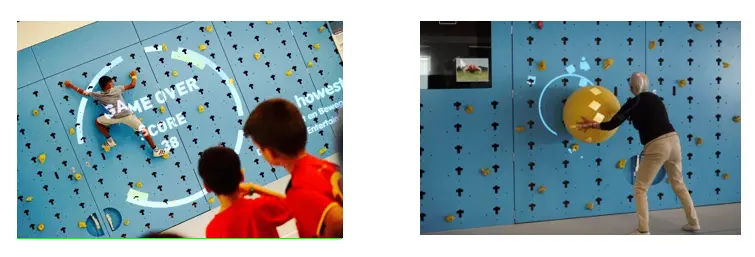
Example: take a climbing game for children, developed at the Sport Innovation Campus. That’s super fun for little ones, but for older people, that might be a bit too much. That’s why we’ve adapted that game so that older people can also enjoy it 🧗.
Why is “sport” sometimes a bad word? #
Many people find sports boring, difficult, or just not fun. That’s why it’s important not to focus too much on the word “sport”. By choosing a different word, like “exercise” or “play,” you make it more appealing to a wider audience.
Example: Many people think that exergames are only for athletes. But that’s not true at all! Take the game Beat Saber. It’s a super fun rhythm game where you can really let loose, without having to be a top athlete. Popular with non-athletes.
Example: Boxing in virtual reality, for example the game The Thrill of the Fight, is more popular with athletes.
In short: #
When you create an exergame, you need to think carefully about who you want to reach, about your target group. Adapt the game to their interests and skills, and use words and terminology that appeal to them.
Tip: Test your game on different types of people. Ask them what they think of it and what could be improved. That way you’ll find out if your game really appeals to your target audience.
Rule 3: make the game fun #
Who doesn’t love a good game? With points, badges, and levels, you feel like a superhero saving the world. And that’s exactly what gamification does: it makes your exergame more fun, challenging, and addictive.
Why is gamification important? #
Motivation: Who doesn’t want to be number one on the leaderboard?
Progress: By earning points and levelling up, you can clearly see your own improvement.
Reward: A badge or a virtual prize is always nice to earn, right?
Example: Pokémon Go uses augmented reality to catch virtual creatures and applies numerous gamification elements. To charm both the young and the old.

Example: For a research project, researchers from DAE Research once developed a running game, Endless Runner, for the Sports Innovation Campus. The goal of the game is to run through a virtual world while avoiding obstacles. You see your speed and your time on the screen, and you get points when you avoid an obstacle. That’s not only fun, but also motivating! The combination of advanced gamification and simple instructions and running movements proved to be a hit.

Example: Gamification can sometimes be very simple. For example, students once developed a cheap and simple game for the Sports Innovation Campus where you had to hit buttons as fast as possible, Zen-It. The reaction time was measured and a leaderboard was kept via an app. You could place the buttons close together or far apart. Simple and fun, and with high replayability to get that high score after all.
But be aware: #
- Too much is too much: Just like with candy, you can also get sick of too much gamification, sometimes literally.
- Customize it: Not everyone likes the same things.
- Keep the goal in mind: Use gamification to achieve your goal, not the other way around.
How to make it fun? #
- Make it challenging: Make sure there’s always something new to discover.
- Give feedback: Show players how well they’re doing.
- Reward them: A virtual prize works wonders.
In short: #
Gamification is a powerful tool to get people moving. But use it in moderation and make sure it fits your game and your target audience.
Tip: Experiment with different gamification elements and see what works best for the goal and target audience you have in mind.
Rule 4: tell a story that sticks #
Ever watched a thrilling action movie and felt like you were part of the action? That’s exactly what storytelling in exergames can do. By telling a good story, you not only make your game more fun but also much more engaging.
Why is storytelling important? #
Immersion: You feel like you’re really in the game.
Feedback: The story tells you how well you’re doing.
Motivation: An exciting storyline keeps you going.
Example: The audio-exergame Zombies, Run! Running for your life to escape zombies, if that doesn’t motivate you to keep running?
Example: Or fighting like a real ninja, who wouldn’t want that? Students developed Sensei VR for the Sports Innovation Campus, fairly basic in terms of visuals but the storyline makes you want to keep playing.
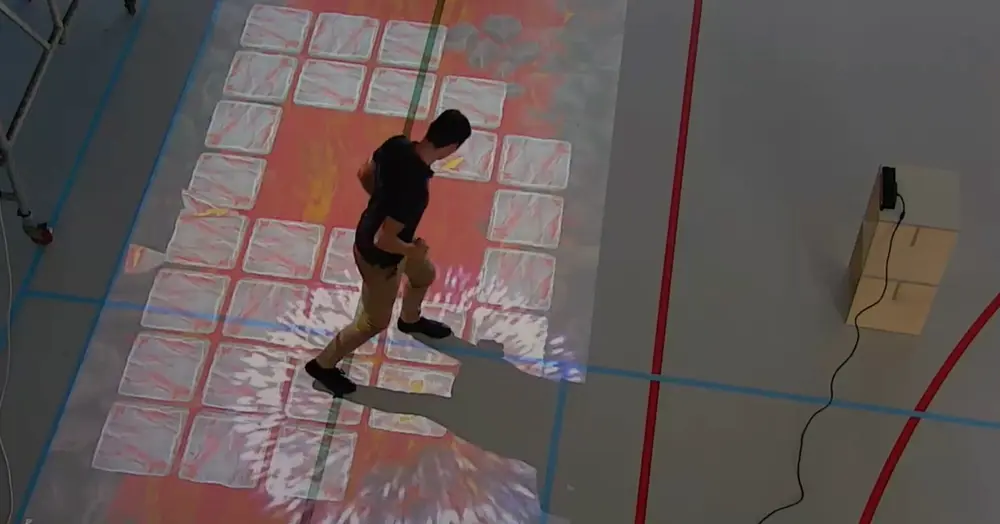
Example: Storytelling can also be very simple. Every child probably played “the floor is lava” while playing. For the Sports Innovation Campus, students developed a version of the game with floor projection. So simple, yet so fun!
How do you create a good story? #
- Choose a story that suits your target audience: Consider their interests and age.
- Use the right technology: Make your story come alive.
- Make it personal: Let players identify with the characters.
- Keep it simple: Not everyone is up for a complicated story.
Why using storytelling? #
By telling a good story, you not only make your exergame more fun but also more effective. People are more likely to continue playing a game if they follow a story or can talk about it later.
In short: #
Storytelling is the icing on the cake of your exergame. It not only makes your game more fun but also more meaningful.
Tip: Dare to experiment and create a story that suits your target audience.
Rule 5: make it personal #
Receiving a random pair of socks as a Christmas present. Perhaps you’ve experienced it and didn’t feel great about it? Absolutely, a gift that’s just right for you is so much more fun. It’s the same with exergames. By personalizing a game, you ensure that players stay motivated and keep going.
What do we mean by that? #
- Tailored: The game adapts to your level and your goals.
- Own choices: You decide how difficult it gets, what music plays, what your avatar looks like, and much more.
Why is personalisation important? #
- Motivation: If you see that you’re making progress, you want to continue.
- Enjoyment: If you can make your own choices, the game is much more fun.
Example: In more performance-oriented exergames, personalization is often well integrated. In EXR (interactive software for indoor rowing), for example, you can create your own custom training schedules, track your progress, and row against people of the same level.
Example: In the popular Just Dance, you can choose your favourite music and dance level.
How do you make a game personal? #
- User profiles: This way the game knows exactly what you like.
- Dynamic adjustments: The game becomes more difficult or easier, depending on your level.
- Freedom of choice: Let players choose how and with whom they want to play.
In short: #
Personalization not only makes your exergame more fun but also more effective. By taking into account the individual wishes of each player, you ensure that they stay motivated and achieve their goals. That personal touch creates a game where everyone feels at home.
Tip: Offer as much freedom of choice as possible, but make sure it doesn’t become too overwhelming.
Rule 6: instant results, instant fun #
You do a set of push-ups and you immediately see how many you’ve done correctly. Or you play a dance game and you get instant compliments for your moves. That’s exactly what real-time feedback does: it gives you instant results, which keeps you motivated and has more fun. And feedback comes in all sorts of forms. The popular Just Dance, for example, gives live feedback on the dance moves to be performed. Virtual reality sports games (often American) are good at giving auditory encouragement. But it can also be about feedback that the user feels, such as vibrations or resistance.
Why is real-time feedback important? #
Motivation: If you see that you’re making progress, you want to continue.
Enjoyment: It’s fun to see what you can do.
Improvement: Through feedback, you get insight into what you’re doing well and where you still need to work.
Example: In commercial, more performance-oriented exergames, feedback is often very well integrated, partly due to the connection with ‘smart’ indoor sports equipment. In Zwift (interactive software for indoor cycling), for example, you can see your speed, distance, and heart rate while cycling and get live feedback on it.
Example: To provide accurate feedback, good sensors are needed. These measure different things in a correct way, depending on the type of game. Think of posture, heart rate, or other biometric data. And that turns out to be not always easy. Integrating physical objects such as weights into an exergame is also not obvious. That is why in virtual or augmented reality sports games there is often no form of resistance yet. Something that was recently experimented with in a student project for the Sports Innovation Campus. Work it AR integrated dumbbells into an augmented reality movement game. A 3D camera detected the height and position of the weights and could track the player’s posture in a non-invasive way. To then give personalized feedback.
How does it work? #
- Sensors: These measure your movements, heart rate, and other data.
- Visualization: You see your results on the screen.
- Audio: You hear compliments or encouragement.
But be careful: #
- Not too much: Too much feedback can be distracting.
- At the right time: Feedback should come immediately, otherwise it has no effect. Unlike classic video games, exergame players can usually tolerate some ‘latency’ (delay) without negatively affecting their gameplay experience. But not too much of course.
- Personalized: Adapt the feedback to the player.
In short: #
Real-time feedback is like a personal trainer or coach who encourages you while you exercise. It not only makes your exergame more fun but also more effective.
Tip: Experiment with different types of feedback and see what works best for your game and your target audience.
Rule 7: together we’re stronger #
You’re playing a really cool game, but you’re doing it all alone. Not so fun, is it? That’s why multiplayer is important: exercising together is so much more fun!
Why is multiplayer important? #
- Motivation: Working together or competing against each other makes the game more challenging.
- Fun: It’s just more fun with friends or other players.
- Social: You make new friends and strengthen existing bonds.
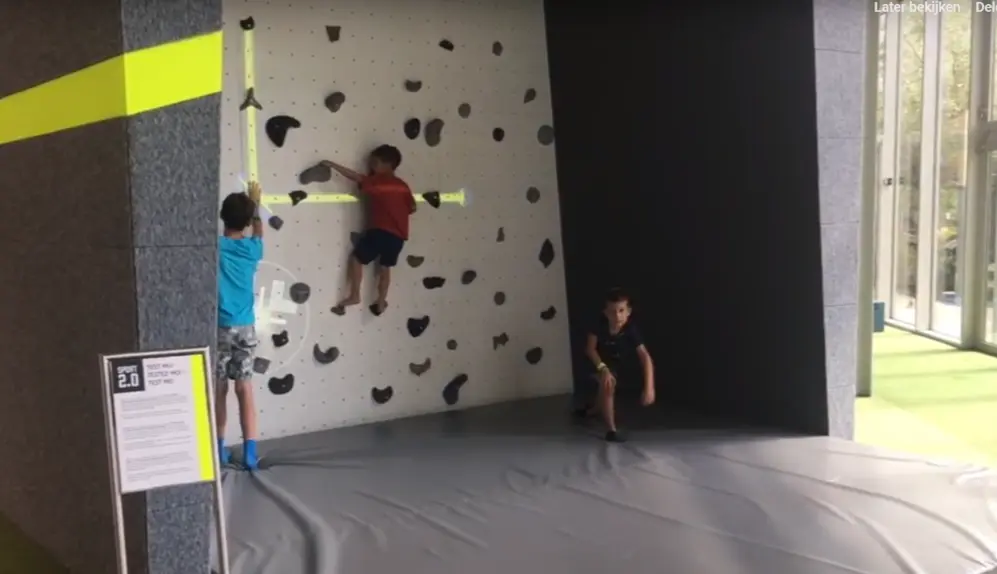
Example: A few years ago, an interactive climbing game based on motion detection was developed for the Sport Innovation Campus. The goal was to tap a projected target as quickly as possible. However, the camera software used could only detect one player at a time. But children (the target audience of the game) found it much more fun to climb the wall together. Consequently, the game often went wild. Luckily, we got a second chance and a new multiplayer variant was developed for Technopolis (an interactive science and technology center in Mechelen). In this variant, children have to work together and apply the principles of mirror reflection to hit a target. It proved to be a huge success.
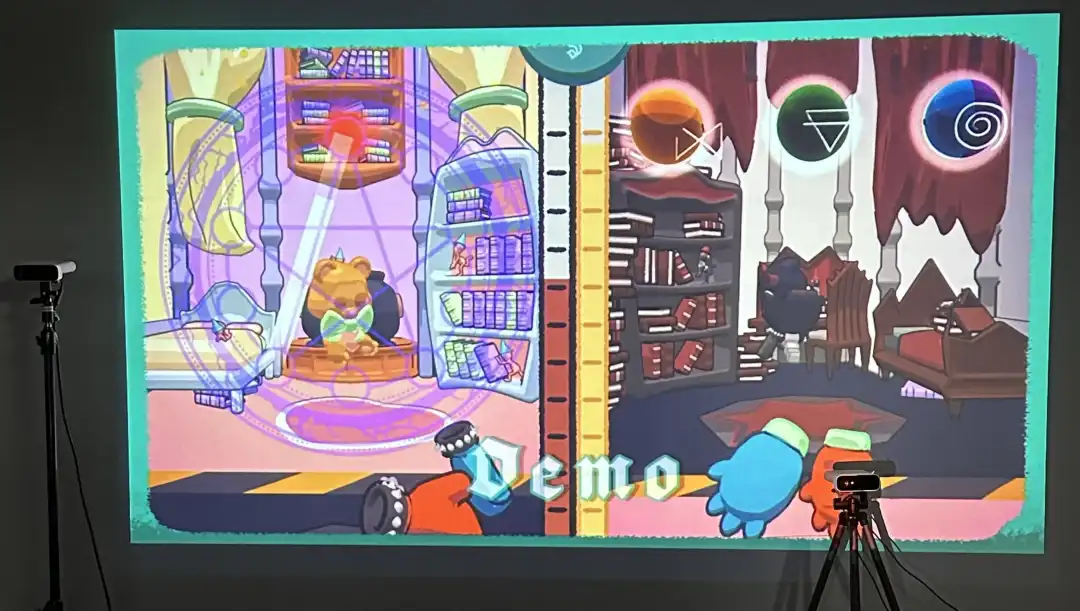
Example: In the previously mentioned multiplayer climbing game in Technopolis, up to five children can play at the same time. Exergames with camera projection, however, are often limited to two players. This is also the case in Hexercise, developed by students, where you and your teammate must combine magical powers (read: movement skills) to progress through the game.
Example: Virtual reality exergames also increasingly offer options to play against or with each other. The breakthrough of real exergame team sports is still awaited, however. An exception is Hado, a kind of futuristic dodgeball where you put on special glasses and shoot virtual energy balls at each other in** teams of 3 against 3**. You see the real world with an extra layer of digital elements.
But be careful: #
- Technology: Multiplayer often requires special equipment. If you want to have 10 people play tennis against each other in virtual reality, you also need 10 VR headsets.
- Alignment: Multiplayer must fit the game.
- Target audience: Different target groups have different needs.
In short: #
Multiplayer not only makes your exergame more fun but also more social. By playing together, people stay motivated and get further.
Tip: Offer various multiplayer options so that everyone can find something to their liking.
Rule 8: as simple as possible, as complex as necessary #
Buying a new phone and having to read a 100-page manual to use it. Not very convenient! A good exergame is like a good phone: easy to use and intuitive.
Why is user-friendliness important? #
- Motivation: If a game is easy to learn, you’re more likely to keep playing.
- Enjoyment: If you don’t have to constantly puzzle over how something works, you can enjoy the game more.
- Safety: A clear interface ensures that you can exercise safely.
How do you make a game user-friendly? #
Simple: The movements should be easy to learn.
Clear: The instructions should be clear, both visually and audibly.
Accessible: The equipment should be easy to use.
Personal: Adapt the game to the individual player.
Example: Les Mills BodyCombat, a virtual reality exergame based on the popular lessons of the same name, offers remarkably clear instructions for everyone, from beginner to advanced.
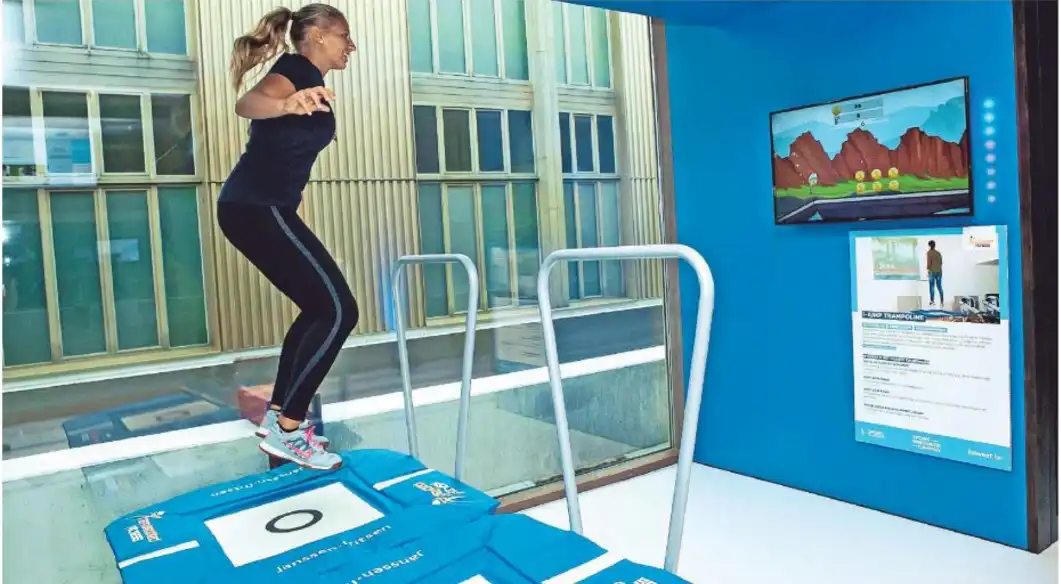
Example: It can also be very simple, like this trampoline game developed by students. Jumping to get ahead in the game, without complicated buttons or a manual.
But be careful: #
- Test, test, test: Ask different people to try out your game.
- Listen to your users: What do they find important?
- Adapt: Be willing to adapt your game based on feedback.
In short: #
User-friendliness is the key to a successful exergame. By creating a game that is easy to learn and use, you not only ensure that people start playing your game but also stay motivated for longer.
Tip: Always think: how would a 10-year-old play this game?
Rule 9: a team of top performers #
If you’re building a house, you need not only an architect but also a carpenter, an electrician, and a plumber. It’s the same with exergames: to create a top-notch game, you need a team of different experts.
Why is a multidisciplinary team so important? #
- Complete picture: Each team member brings their own expertise.
- Better results: By working together, you arrive at better solutions.
- User-focused: The focus is on the needs of the player.
Who is on an exergame team? #
IT-experts: The technicians who bring the game to life.
Behavioral scientists: The psychologists who know how to motivate people.
Sports scientists: The experts in the field of movement and health.
Designers: The creatives who make the game look beautiful.
Game designers: The storytellers who come up with an exciting story or original concept.
Example: The student-developed Bird’s Beats, based on Angry Birds, is a good example of an original concept. The game teaches children to control their heart rate. The higher your heart rate, the harder the catapult is stretched and the further you can shoot.
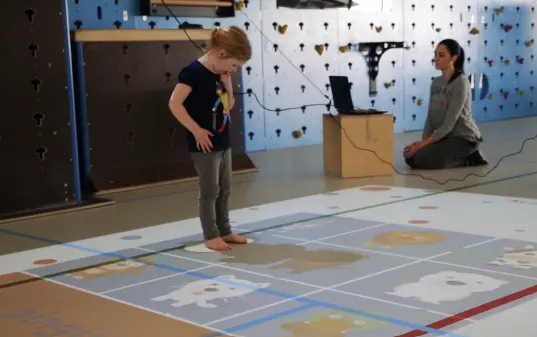
Example: Not only development, but also implementation is a multidisciplinary challenge. For the student-developed Let’s pie, for example, close cooperation took place with educational professionals. Various games can be played via floor projection, from search games to math games, each with an adjustable difficulty level.
But be careful: #
- Collaboration: It’s important that everyone works well together. And so not next to each other.
- Time: Multidisciplinary projects take time.
- Expertise: Make sure you have the right people on your team.
In short: #
A multidisciplinary team is the key to a successful exergame. By combining different expertise in a dream team, you create a game that is both fun and effective, and looks good too.
Tip: Organize regular meetings to keep everyone on the same page.
Rule 10: the indispensable coach #
Workout apps are all over the app store, but it’s not always clear in those apps how to perform all the exercises correctly. Let alone getting personalized guidance. In that sense, a human coach is still often preferred. It’s the same with exergames: a good guide often makes the difference between success and failure. The digital or virtual aspect of exergames therefore does not mean that less guidance is needed. On the contrary. A game may work technically excellent, but it does not automatically induce enough movement.

What makes a good coach? #
Knowledge: A good coach knows the game inside out.
Pedagogy: A good coach can motivate people, provide customized instructions, and give players that extra push.
Adaptation: A good coach can adapt the exercises to the player’s level and ensures that players feel connected to the game and any other players.
Safety: A good coach pays attention to the safety of the players.
Example: A ‘real’ coach who says during an augmented reality game at Active Arcade: "Quick, put a bit more power into your legs to knock out that robot on the left too”, that has more impact than a digital voice in the game.
But be careful: #
- Training: Coaches must be well trained. At the Bachelor’s program in Sports and Exercise Sciences at Howest University, for example, learning to guide exergames is a standard part of the curriculum.
- Materials: Coaches need good materials (manuals, instructional videos) to do their job.
- Network: Coaches need to be able to work together, inspire each other, and share best practices.
In short: #
A good coach is the key to a successful exergame. By training and supporting coaches well, you ensure that players get the most out of their training.
Tip: Organize regular meetings for exergame coaches to exchange knowledge and experiences.
Exergames: one of the keys to a more active (and fun) life #
Exergames are not just games; they are a revolutionary way to have fun and get in shape. By combining the best of both worlds – gaming and sports – exergames offer an attractive and effective solution to get people of all ages moving.
10 golden rules for successful exergames: #
- Goal-oriented: What do you want to achieve with your exergame? Do you want to get people moving or teach new skills?
- Tailored: Know your audience! Adapt your game to the interests and level of your players.
- Addictively fun: Use gamification elements such as rewards and levels to keep players motivated.
- Storyline: An engaging story makes the game even more interesting and ensures that players want to continue.
- Personalized: Let players put their own stamp on the game.
- Instant results: Give players immediate feedback on their performance.
- Together we’re stronger: Multiplayer functions make the game more social and fun.
- Simple and intuitive: Make sure everyone can play the game, regardless of technical knowledge.
- Teamwork: Collaborate with experts from various fields for optimal results.
- The power of coaching: A good coach can make the difference between success and failure.
Ready to create or implement your own exergame? #
The possibilities are endless! Contact the Sport Innovation Campus for more information, inspiration, and support. Together we’ll turn the world into a playground!
